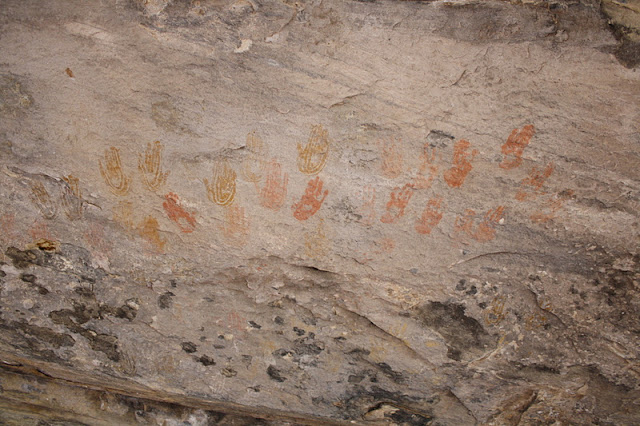For Moab's Helen M. Knight Elementary school third graders, the fall field trip is one that is talked about for a long time after it is done. We did this field trip 6 days-- and I must say that it was definitely the most fun to teach! Our stations are talking about the concepts of simple machines, like levers and wedges. We also talk about the classes of the machines (first, second and third) and how the ancient people used them to make their every day jobs easier.
Ranger Kelly talks to the kids about using your whole arm when throwing something in order to get the most force out of the action. She taught the Atlatl station that day, and this was a test to see if the kids could follow instructions properly.
Ranger Karen shows the kids how to make fire with a hand drill and a fire bow. The kids each got a chance to try and make their own fire, but mostly we only got smoke.
The third graders try to make fire using a hand drill.
At my station, we discussed different things that the ancient people used rocks for, and then we talked about how they used a mano and matate to grind corn. A mano is a first class lever, and the corn is the load. We talked about how grinding corn was a big part of Anasazi life and how much corn it would take to feed a family.
Here I am showing the kids the proper way to hold the mano and how to grind the corn. Each kid got a chance to grind the corn, and they really enjoyed it.
Each kid got the chance to grind the corn and we talked about how the women in the family would do this all day in order to make sure that their family would be able to eat that night. We also talk about how there are certain foods that we as humans cannot properly digest unless they are ground up or boiled. Wheat and rice are two examples of that. The Anasazi would grind corn into powder and make it into other food items because it was easier to eat it that way.
"Would you want to grind corn all day, every day? Do you think you'd get bored really quickly?"
So now that we spent all that time growing our corn, collecting the seeds and grinding it into powder to make it into food, is it important that we collect everything and keep it until we need to use it to cook food?" We collected the ground corn in my 'ancient' cottage cheese container. Collecting the powder also gave the students an opportunity to see how much sand got into our corn. The Anasazi had many dental problems because of the amount of sand that got into their food from grinding.

Now it's time for the kids to make their own stone tools. We talked about how arrowheads and scrapers took a lot of time and skill to make, and how a lot of times we fail to notice that the ancient people also used tools that did not take a long time to create. The kids each put on safety goggles and find a rock. When you take a rock and smash it against another rock, if you hit the rock just right, it will create a weakness within the rock and the rock will break, hopefully creating a flake or a 'wedge' that could be used as a tool. After the kids show me that they can follow instructions, we throw our rocks.
"Okay, so you are going to take your rock in your hands and wait until I say one, two, three, throw!" When I say the word 'throw', you are going to take your rock, hold it over your head, and throw it as hard as you can against the other rock. Then, you are not going to pick up your rock or the pieces until I say the words 'ALL CLEAR'."
The kids patiently wait for me to say "all clear". Some kids made some really cool tools, while others didn't have very much luck. It was fun having them show me their rocks (broken or not) and for them to tell me what they would use them for if they were part of an ancient tribe.
Here I a leading the kids to their next station!
At Ranger Heidi's station, the kids learn about how the ancient people used digging sticks to pry tubers out of the ground. The digging stick is a lever, and the tuber is the load. We hid clay 'taters' in the ground and the kids have to find them and pry them up with their digging sticks.
The kids search for the tubers, count them, and then hide them again so other kids have a chance to find them.
Ranger Kelly talks to the kids about how to use atlatls. Unfortunately, my camera died before we could get any pictures of her doing the Atlatl station. I got a lot of pictures when I taught it, though, so be on the look out for those!

































































